| The Barbizon School. L'école de Barbizon. Texte français : Bernard Rey Let us imagine for a moment, a small village at the edge of Fontainebleau Forest, its meadows, its fields of corn, cows grazing, its farming folk living their tranquil lives. Imaginons un instant, un petit village à l’orée de la forêt de Fontainebleau, ses prés, ses champs, ses vaches, ses paysans tranquilles. |
|
 Paule Séailles –Sketches of Chailly and Barbizon- Paule Séailles - Pochades de Chailly et Barbizon - |
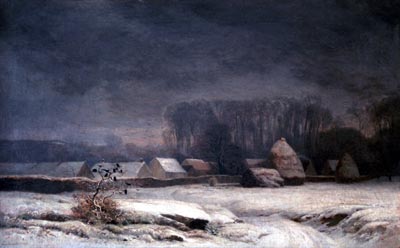 Eugène Lavieille -Barbizon in the snow- Eugène Lavieille -Barbizon sous la neige- |
One day, a bearded character arrives, adorned with tubes of paint (a novel item at the time), brushes, canvases and easel, complete with hat pushed onto his head -and a pipe between his teeth seemingly to ward off mosquitoes! Arrive quelque barbu bardé de tubes à peinture (nouveauté de l’époque), pinceaux, toiles et chevalet, chapeau sur la tête, pipe au bec pour chasser les moustiques dit-on ! |
|
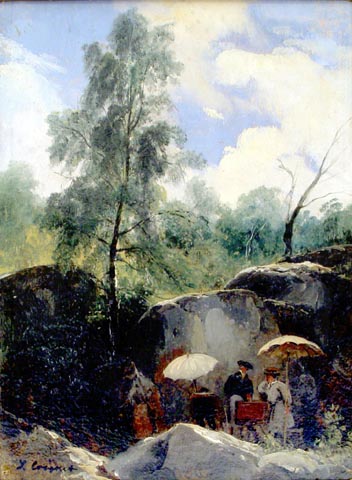 Jules Coignet -Outdoor painters- Jules Coignet - Peintre sur le motif- |
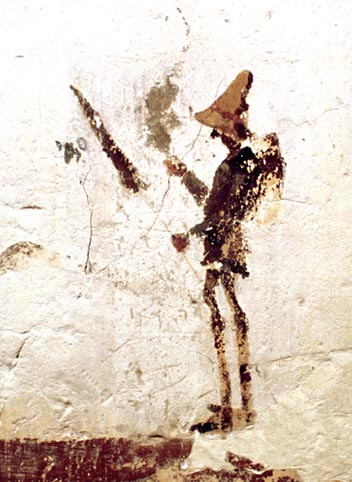 Anonymous -Artist at work- Anonyme -Peintre au travail- |
A school of painting is born : BARBIZON ! Une école est née : c’est BARBIZON ! |
|
|
The beginnings (1820-1840)
It was 1822 when Camille COROT visited the Forest of Fontainebleau for the first time. Others were to follow, like Henry TROYON who from 1830 often stayed at the Ganne Inn, or Theodore ROUSSEAU who moved to live in Barbizon in 1835. Les débuts (1820-1840) C’est dès 1822 que Camille COROT rend une première visite à la forêt de Fontainebleau. D’autres suivront comme Henry TROYON qui fréquente l’auberge Ganne à partir de 1830 ou Théodore ROUSSEAU qui s’installe à Barbizon en 1835. |
|
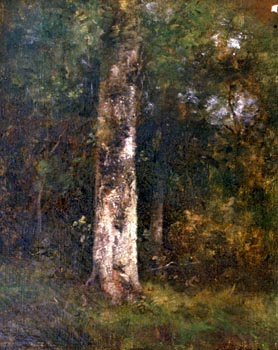
Léon Richet -Tree study- Léon Richet -Etude d'arbre- |
|
| The wayfaring artists (1840-1850)
The landscape attracted more and more artists, often those in revolt against classical, academic studio-based painting. Les Voyageurs (1840-1850) Le paysage attire de plus en plus d’artistes, souvent en révolte avec la peinture académique d’atelier. The peak of activity -the 1850s Theodore ROUSSEAU had at last gained recognition. Around him, the world of Barbizon was well organized. Jean-François MILLET was working hard and struggled to sell his works, which were devoted to the rural life he observed around the village. DIAZ de la PENA, more comfortably off financially, brought assistance to many. Others kept coming and going, among them Jules DUPRE, a close friend of ROUSSEAU, Charles JACQUES who met up with MILLET again, Paul HUET or the young Leon BELLY. The inn was packed with artists! l’apogée des années 50. Autour de Théodore ROUSSEAU, enfin reconnu, le monde de Barbizon est bien organisé, Jean-François MILLET travaille dur et peine à vendre ses œuvres consacrées à des sujets centrés sur la vie du monde rural alentour, DIAZ de la PENA plus à l’aise financièrement apporte son aide à beaucoup et d’autres vont et viennent comme Jules DUPRE très intime avec ROUSSEAU, Charles JACQUES qui retrouve MILLET, Paul HUET ou le jeune Léon BELLY ; Ça fait du monde à l’auberge ! |
|
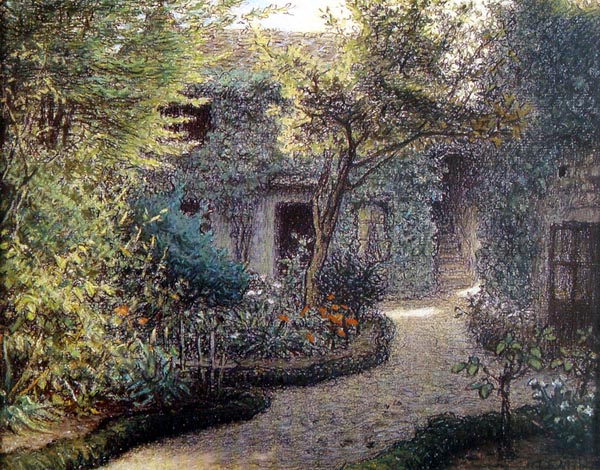 J.F. Millet -The house of Théodore Rousseau- J.F. Millet - La maison de Théodore Rousseau- |
|
| When impressionism was born (1860-1870)
Just as there is no denying that the Barbizon School was strongly inspired by the Flemish and Dutch landscape school of painting, indeed also by the English landscape School, Barbizon unarguably was a highly fertile medium for generating developments that presaged impressionism. The prestige of Barbizon’s grand masters and many aspects of the School’s approaches contributed to the future of painting. Their methods and sensibilities were influential, like the practice of working in the open air (with a canvas for the morning, a snack for lunch, and a canvas for the evening), making the most of the effects of light as the day proceeds. They were eventually encouraged by a certain shift in the tastes of the public who discovered something different from the historical or religious academic ethos. “Ordinary” men and women, at work on the farm or in the woods and fields, are shown in a perspective quite different from the stiff rigidly-organized academic portraits. Their art gave a foretaste of painting’s emancipation, which was to lead, beyond the then-budding impressionist movement, to schools that were to be increasingly freed from the rigour of set norms and classical representational art. Quant naît l’impressionnisme (1860-1870) Tout comme, on ne peut le nier, l’école de Barbizon a fortement été inspirée par les écoles flamandes et hollandaises du paysage, mais aussi par la peinture paysagiste anglaise, Barbizon est incontestablement un ferment très actif pour le développement de l’impressionnisme. |
|
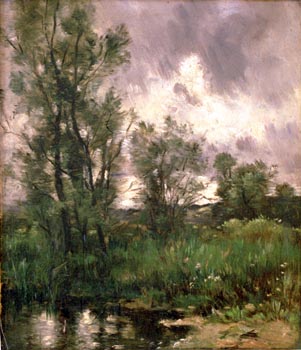 Louis Watelin -Trees and thickets around a pond- Louis Watelin - Arbres et fourrés au bord d'une mare- |
|
| Where does nature come in to all this ? Well-known spots in Fontainebleau Forest, like the Franchard Gorges, the Chailly Pavement, the Apremont Gorges and the area’s oaks, were first immortalized by Barbizon’s painters.
Et la nature dans tout ça ! |
|
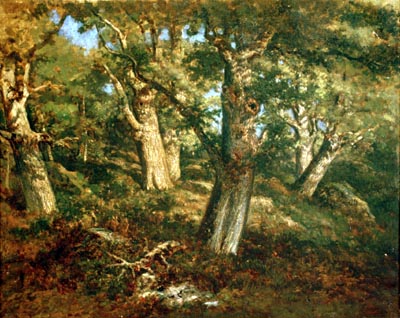 François Ortmans – Oaks in the Forest Fontainebleau- François Ortmans – Chênes en forêt de Fontainebleau- |
 Charles Ceramano – After the forest fire, Fontainebleau- Charles Ceramano – Après l'incendie, Fontainebleau- |
Looking closely at the scenes painted, one can believe one is there. And if we look for these sites when walking in the forest, we still find the places where Barbizon’s masters practised their art. Naturally, the landscape has changed, or evolved into another form. This is quite normal. All the paintings capture a world that is certainly mineral in character, and therefore varying little at our scale. But predominantly it is one of vegetation, alive with all its troubles, the life, death, renewal (or regeneration, in the terms of the forest) of individual organisms and mixed collections of species, in competition with each other for water, light and minerals. A les bien regarder, on y est presque et en cherchant vraiment on retrouve sur le terrain, les lieux où nos maîtres ont exercé leur art. Evidemment le paysage a changé, évolué plutôt et c’est bien normal. Toutes ces toiles ont pour objet un monde certes minéral, donc peu variant à notre échelle, mais surtout végétal, vivant avec tous ses tracas, la vie, la mort, le renouvellement (on dit régénération pour la forêt) d’individus et d’espèces mélangées, en concurrence entre eux pour l’eau, la lumière et les minéraux. |
|
 Anonymous -Oil sketch painted on a fireplace in the Ganne Inn- Anonymous -Oil sketch painted on a fireplace in the Ganne Inn- |
 François Chaigneau -Sunset over the plain- François Chaigneau -Sunset over the plain- |
| That brings us to a few words on water. The extensive forest massif of Fontainebleau, stretching about 25 000 ha (in other words the equivalent of a square with 50 km sides), abounds in ponds and wetland habitats that have also gave inspiration to our unrepentant brush-carrying ramblers. L’eau parlons-en peu aussi, Fontainebleau au prestigieux massif forestier de quelques 25 000 ha (c’est à dire un carré de 50 km de côté) regorge de mares et de milieux humides qui ont aussi inspiré nos impénitents randonneurs du pinceau. |
|
 Charles François Daubigny -River- Charles François Daubigny -River- |
 Eugène Cicéri –Waterside scene- Eugène Cicéri –Waterside scene- |
| Nature in the forest, however, expresses itself evidently through its trees, the trees dear to us all, like the oak dear to all forest lovers, but especially dear to ROUSSEAU or the silver birches admired by DIAZ de la PENA.
Mais à y bien regarder la nature en forêt c’est tout de même les arbres, les arbres chers à tous, |
|
 Theodore Rousseau -Forest animals’ lair, Apremont - (drawing) Theodore Rousseau -Le dormoir , Apremont - (drawing) |
|
| All these elements set the scene. The Barbizon School, with all its character and range of perceptions, at the same time. |
Le cadre est maintenant posé. L'école de Barbizon avec toute se sensibilité. |
| Naturalistic, the artist is faithful to the model presented by the setting, faithful to the qualities of light. |
Naturaliste, on est fidèle au modèle environnemental, on est fidèle aux lumières. |
| Social, the artist is faithful to the rigours and pains of men and women working hard for their living. |
Sociale, on est fidèle aux peines des hommes qui travaillent dur. |
| And of course, above all, artistic, in the intelligence deployed in the use of colours and compositions,…decidedly marks a turning-point between two great eras of artistic expression. |
Et bien sûr, et surtout, artistique, par l’intelligence des couleurs, des compositions,est bien cette charnière entre deux grandes époques de l’expression artistique. |
 Ferdinand Chaigneau -Landscape on the plain (watercolour) Ferdinand Chaigneau -Paysage de plaine (aquarelle |
 Georges Gassies -Harvest on the plain at Chailly (watercolour) Georges Gassies -Moisson dans la plaine à Chailly (aquarelle) |
| These few lines are intended as a guide to help visitors find their way through the multitude of messages that our companions with the easels and long umbrellas have abundantly left us on the walls, the woodwork and furniture of the GANNE Inn. Que ces quelques lignes aident le visiteur à maintenant voyager à travers la foultitude de messages que nous ont laissés sur les murs, les boiseries et les meubles de l’Auberge GANNE, |
|